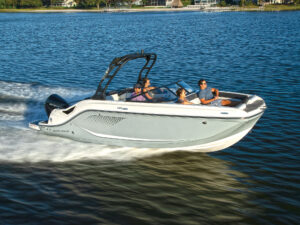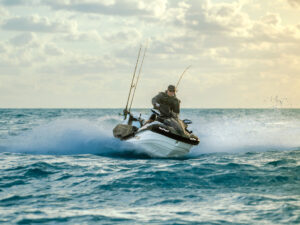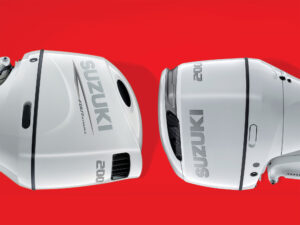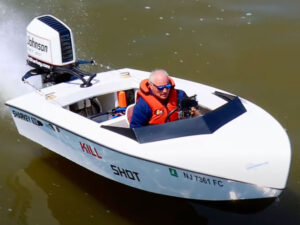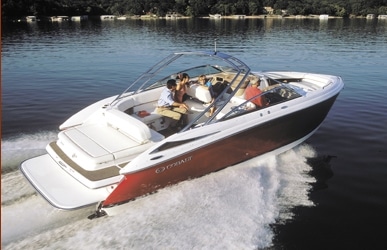
Cobalt 302
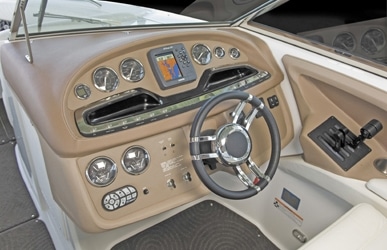
Cobalt 302
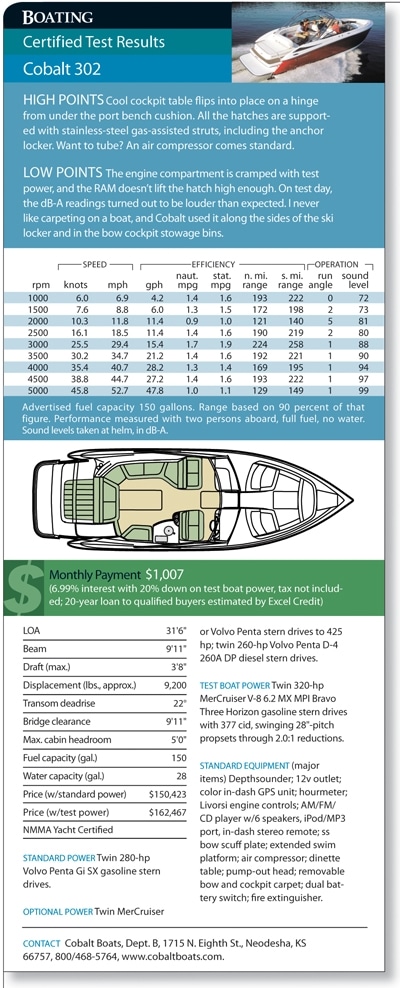
Cobalt 302 Specs
This is the type of sportboat that Barry Bonds would love. Don’t get the connection? This boat is your typical family boat after emerging from the Balco program. Still not getting it? The Cobalt 302 is a bowrider on steroids. With a centerline length of 29’7″ and a beam of 9’11”, this is a spacious, amenities-packed party monster in runabout form.
Pack it in. Stretch it out.
The dayboat category-used to describe large bowriders-isn’t crowded. And there aren’t many others as expensive as the 302. The Sea Ray 290 Select EX, a well-built boat with plenty of amenities, comes in about $5,000 below the Cobalt, selling for $143,086 with twin 320-hp MerCruiser 6.2 MPI Horizon Bravo Three gasoline stern drives. Monterey offers its 298 Select SSX ($139,062 with the same power); Rinker sells its smaller 296 BR, which only offers single-engine power ($84,304 with a 425-hp MerCruiser 496 MAG HO Bravo Three stern drive). The best direct comparison for the Cobalt 302 is the Formula 310 Bowrider ($184,736 with twin 280-hp Volvo Penta stern drives). Like the Cobalt, the Formula has plenty of well-appointed space and comparable on-water performance, save for a slightly slower top end. The Cobalt holds 20 more gallons of fuel and has a few standards-the air compressor and bow scuff plate-that the Formula lacks. But the Formula has some standards not found on the Cobalt, and it has a nicer head, with cherry flooring and a vacuum-flush commode.
How does Cobalt justify the high sticker? It’s all in the details. Many things combine to help this boat fulfill its mission of being a family entertainment center. Start with the large sunlounge atop the engine hatch. It’s big enough for two to tan. Its backrest adjusts so people can kick back and look aft while at rest or face forward in the cockpit underway. A beefy stainless-steel rail runs along the entire extended swim platform, providing crunch protection and giving swimmers a place to grab. There’s a dedicated stainless-steel grab handle at the boarding ladder.
The cockpit lounge is massive, with U-shaped seating that can seat 12 to 14 people. (Feel free to pack ’em in. A boat this big must be yacht certified, so there’s no maximum passenger load.) Room for guests isn’t an issue, nor is the means to entertain them. Six Sony speakers are placed strategically throughout the boat, and the CD player has a port to accept iPods and other MP3 players. Behind the helm, the galley has a Corian counter, a stainless-steel sink, a cooler, and a stainless-steel grab handle that serves as a fiddle. Stainless-steel cupholders keep cold drinks within arm’s reach.
My favorite entertainment feature in the cockpit is the dedicated spot under the port seating for the flip-out table. What’s that? Basically, the dinette table is hinged. Remove the seat cushion and swivel the hinge and the table flips out and locks in place. There’s no assembly or disassembly, nor any fumbling with the table pedestal. It’s a simple, effective feature that will make your on-water entertaining that much less of a hassle.
The 302 also differs from the competition in its bow cockpit seating. There actually are seats. The arrange-ment makes one of the most comfortable bow seating configurations I’ve tested.
Toy Story
Being at the helm of the 302 is entertainment in and of itself. With the twin 320-hp MerCruisers, my test boat was fun to drive. It shot onto plane with minimal bowrise and had pleasurable midrange oomph. It took no time to achieve the top speed of 52.7 mph.
Underway, I took the boat through turns and S-curves at high speeds, and it always felt safe and predictable. I crossed boat wakes at 40 mph-no rattles, no pounding, no problem. The helm makes it easy on the driver, too. The doublewide captain’s seat has a flip-up bolster, a molded-in angled footrest, and an armrest for your throttle arm. All the gauges are clearly visible even if you tilt the wheel. Plus, the dash has a dimmer so you can adjust the backlighting of your gauges for best viewing. A Garmin GPS unit and Livorsi controls come standard.
How about watersports? The 302 has a built-in air compressor to blow up your tubes as well as two large in-sole stowage lockers to swallow your toys. The hatch in the cockpit opens on twin gas-assisted stainless-steel struts. There’s stowage for fishing rods under the hatch. A rubberized mat keeps things from bouncing around, and you can just flip on a light if you can’t find something. The second stowage locker resides in the walkway between cockpits-its hatch also has gas-assisted struts. This locker is big enough to store skis and also has a rubberized mat. But two questions arise: Why did Cobalt carpet the locker sides? And where does the collected water drain? I couldn’t find a drain on our test boat.
Hot Construct
Of course, the 302 lives up to Cobalt’s reputation for high-quality construction. Looking in crevices illustrates this-the hull-to-deck joint is backed with a wooden strip, and all the wiring is loomed and properly supported. Hoses are held in place by screwed-in metal clamps. The engines are mounted onto the stringers and on a cross-support metal beam with through-bolts. This attention to detail carries over into the little things, such as outfitting the anchor locker hatch with a gas-assisted strut and adding a rubberized mat in the locker, or securing the windbreak door with two latch bolts-one vertical, one horizontal-to reduce rattling.
So what’s not to like? Although the electric engine hatch was smooth and quiet, it didn’t raise high enough. And with twin engines under the hatch, working space for maintenance is cramped. I was also surprised by the louder-than-expected dB-A readings, so I’m wondering if the engine compartment on our test boat was missing insulation. But overall, the 302 has the juice to make your day on the water a home run.
Extra Point: The snaps for the canvas covers are filled with a piece of black rubber to protect the hull from water intrusion.

